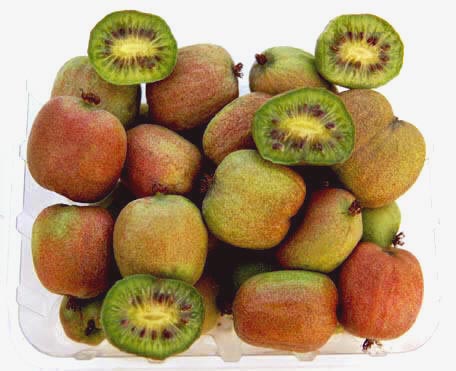|
Kiwiberries should be
allowed to ripen at room temperature. Their skin will turn
darker green, become slightly wrinkled, and they will yield
to gentle pressure when ready to eat. The photo bar above shows the
visual difference.
|
Slightly wrinkled when ready! |
| |
|
 |
|
For best
storage life refrigerate the Kiwi Berries in the coldest part of your
refrigerator (usually the shelf on top of the produce drawers). The
fruit will hold for up to a period of two weeks or longer. |
|
|
When you are ready to eat the Kiwi Berries take out the number of
clamshells you wish to use and put them on the kitchen counter to
ripen. |
|
|
|
Everyone’s concept of ripe is different so you can try them as they
mature to identify the stage where you enjoy them. |
|
You can hasten the ripening
process by placing the berries in a paper bag at room temperature.
Don't try this process with conventionally grown kiwiberries...most fruit is picked too early, ripened with ethylene, and will only
store for a short period of time before it becomes watery.
With their smooth skin,
Kiwi Berries are sensational
for out-of-hand eating.
They are perfect for snacks
and make a healthy addition to a lunch box. Containing almost 20 vital
nutrients - they're not just
delicious - they're good for you!
Read more about
Nutrition.
Kiwi Berries are very
versatile when it comes to culinary creations too. Add them to your favorite recipes. They
can be used as an ingredient - not
just a garnish.
We have processed fresh
berries in a Squeezo and have made what we call "puree" (pure fruit pulp)
that gives the fruit even more latitude for experimentation.
You can freeze puree in zip lock bags for up to a year.
We have
found many uses for our fruit and puree through our own experimentation, and
that of our culinary friends, some of which are salad dressings,
vinegars, salsas, marinades (it's an excellent natural meat
tenderizer)appetizers, sauces for entrees, ice cream, sherbet,
yogurt, sorbet. Kiwi pairs well with orange, honey, and
chocolate. We have also created beverages from non-alcoholic spritzers and health food drinks to wines, meads, and beers.
The uses are
limited only by one's imagination...have fun and enjoy!
Please Take Note of
the Sections Below:
Latex Allergy
and Food:
Some people with latex allergy have allergic reactions when eating
particular foods, including avocado, banana, chestnut, kiwifruit,
passionfruit, plum, strawberry and tomato. This is because some of the
proteins in latex that cause latex allergy are also present in these
fruits.
Oxalic Acid
Sensitivity:
Kiwifruit are high in oxalate, so those with kidney urinary stones may
also need to avoid eating them. Additionally, kiwifruit are high in
potassium, which may be a concern for patients with kidney disease.
|